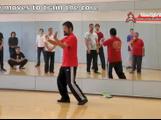Every move in Taiji is a downward move. This begs the question how many moves can you make before you are sitting on the floor? Master Chen says if you can make every move a downward move without going down then you have got it. The key is that downward is a rotation. This rotation is called sinking.
Take the movement in Fetching Water: the body appears to go physically downward but the person does not actually go up and down. What’s actually happening is a rotation in the joints. To demonstrate this Master Chen sat down on the steps with a cylindrical water bottle pressed between his knees; the top of the bottle pressing into one knee and the bottom pressing into the other. “Imagine a line on the top” he said, then he rotated the cylinder 180 degrees down. “Do you see where the line is now?” It was on the bottom. “This is rotation.” To clarify he explained that in relation to the original position the line was on the bottom, but the cylinder had never moved, it only rotated. This action is sinking. Sinking is not going down, it is a rotation.



{ 4 comments… read them below or add one }
Good notes. I often use the concept of right hand rule and left hand rule to remind myself.
Thanks for the comment, I have been trying to record what Master Chen says very carefully without adding anything. Could you please explain right hand rule and left hand rule, I don’t understand what that means.
In one of Master Chen’s workshops he mentioned that a screw rotates on a plane, but as it rotates, it has a force perpendicular to the plane. I use right hand and left hand rules to remind me the 3 dimensional relationship of rotation and sinking.
In terms of the real right hand and left hand rules, I found the following description from Internet: (electromagnetism) For a current-carrying wire, the rule that if the fingers of the right hand are placed around the wire so that the thumb points in the direction of current flow, the fingers will be pointing in the direction of the magnetic field produced by the wire. Also known as hand rule. For a moving wire in a magnetic field, such as the wire on the armature of a generator, if the thumb, first, and second fingers of the right hand are extended at right angles to one another, with the first finger representing the direction of magnetic lines of force and the second finger representing the direction of current flow induced by the wire’s motion, the thumb will be pointing in the direction of motion of the wire. Also known as Fleming’s rule.
This is an interesting analogy. Thanks.